Makar Afanasyevich Zenuhin
Makar Afanasyevich Zenuhin is an Old Believer who has lived on a farm near Woodburn, Oregon, since immigrating to the US from Argentina in 1971. He is 76 years old and has 10 children, most of whom live nearby. Retired after many years of contract work as part of a forest maintenance crew, and independently in construction, Makar Afanasyevich, since the mid-80s, now serves as the Assistant Pastor (помощник наставника) of the St. Nicholas prayer hall, one of the Old Believers’ priestless prayer halls.
Both of Makar Afanasyevich’s parents belonged to the Old Believer tradition, though they were born in different parts of Russia: his mother came from a village in the Orenburg district (south of the Ural Mountains), and his father was from the Altai territory (in southern Siberia). They met and married in eastern Kazakhstan, in a small village located on the banks of the Kurchum River. Both families arrived there in the early 1920s, fleeing the political turmoil, economic devastation and religious persecution unleashed by World War I and the Russian Revolution. Soon, however, the new Soviet government extended its authority to Kazakhstan, and the Old Believer community there decided to cross the Chinese-Soviet border and establish a new life in the rural outer reaches of China. They started a small settlement called Kom in the province of Xinjiang (Синьцзян), close to the borders with the Soviet Union and Mongolia. Makar Afanasyevich was born there in 1938. He was the sixth child in his family. When the family fled to China, one of his three older sisters had been left behind in Kazakhstan with her grandmother. Later Makar’s father had to cross the border three times before he could rescue them. It was a difficult and dangerous mission.
Life in this remote corner of northeastern Xinjiang was peaceful only for a short period of time. As a small child, Makar Afanasyevich recalls frequent military clashes when the “Dungans” (дунганы) and the Kazakhs (both are Muslim), and other violent ethnic groups, attacked the Russians and Chinese, killing Old Believers and burning their homes. Later, at the end of World War II, when the Soviet Union entered the war with Japan and invaded western China, armed conflict in the area intensified. The appearance of the Soviet army in the Old Believer communities in China was followed by a propaganda campaign urging Russians to return to their historical homeland. Most of the Old Believers agreed to repatriate. Makar’s parents refused to go back. They relocated to the town of Kul’ja (Кульджа) and later to a small nearby settlement named Chashi (Чаши), where they lived from 1947 to 1953. Makar Afanasyevich recalls that Chashi, located in the mountains, was beautiful, and the Old Believers were able to harvest fruit and hunt there, and practiced their religion in peace.
With the Chinese Communist Revolution in 1949, however, the Old Believers’ peaceful life in their remote mountain sanctuary came to an abrupt end. Some were arrested, including Makar’s father and uncle, though luckily both were released shortly afterwards. Many Old Believers were forced to take part in Communist “re-education.” In 1953 the family had to move again, this time to a settlement named Turgenchagan, where Makar’s older and already-married sisters lived. It was here that Makar met his future wife, Taisia. They were married in 1955; both had just turned 18 years old. They lived there until 1959, and had their first three daughters during this time.
As a young man, Makar was “drafted” to work in a coalmine, a very strenuous and dangerous job. Afterwards, he worked as a logger. Not only was it impossible for the Old Believers to escape such difficult labor, it was becoming harder and harder for them to practice their religion and traditional way of life.
The charity organization Red Cross, and the World Council of Churches, a global organization of Christian churches, learned of the Old Believers’ plight in Communist China and came to their aid. These organizations chose Kul’ja as a central gathering point for several Old Believer communities experiencing the same problems and wishing to find a way out; there, they prepared them for movement to Hong Kong and then from Hong Kong to the West, where refugee status and other assistance (including land) was promised. Makar, along with another member of his community, was chosen to go to Kul’ja to receive money for the groups’ trip to Hong Kong. He recalls that the local bureaucrats harassed him at every occasion and made his task extremely difficult, but Makar was able to get to Kul’ja and receive the travel money. He then sent word to his wife and family to come join him in Kul’ja.
His wife with a baby and a blind aunt were fortunate to find transport to Kul’ja, whereas other members of the family had more trouble. When the Communist Commune learned that Taisia and others had left, they took Makar’s mother-in-law and his four-year old daughter and others as hostages. They let them go when they found that they did not have enough food for them. To get from Turgenchagan to Kul’ja and meet Makar and the rest of the family, this small group, which included children, then had to walk the 120 kilometers for three days.
Needless to say, even the relocation from Kul’ja to Hong Kong entailed many difficulties and dangers. From Kul’ja, the group traveled by truck four days to the railroad station. From there, it took almost a week by train (with the cheapest accommodation) to reach Guangzhou (Canton). After being “cleaned” of most of their possessions by Communist custom inspectors, they were finally allowed into Hong Kong.
Further difficulties awaited them in Hong Kong. During their long and exhausting trip through China, some members of the group had gotten sick with diphtheria, and everyone needed to be quarantined for a month in Hong Kong before being allowed to travel further. In addition, the group’s initial plan to travel to Brazil with other Old Believers was canceled because one family member was blind: Brazil would not accept refugees with disabilities. Instead, they received papers allowing them to go to Argentina. Ironically, the blind aunt died just before their departure to South America, but there was no time to change all the papers and send the group to Brazil instead.
In 1961, the group left Asia aboard the Dutch vessel Inter, on a two-month sea journey with short stops in such places as Singapore, Mauritius, the port of Durban, South Africa and finally Brazil. Some Old Believers were permitted to settle in Brazil, including the family of one of Makar’s oldest sisters. The rest, including Makar’s family, had to continue to Argentina.
Upon their arrival in that country, they stayed for a month with other Russian-speaking immigrants on the outskirts of Buenos Aires. Then they moved to a rural area of Argentina where the government had allocated land for them. The new place had the alluring name of “Blue Valley,” but it turned out to be a barren, sandy site where they found a newly built shed (барак) and a newly dug and sandy well waiting for them. In this new “home,” they found a bag of bread, a bag of potatoes, and a piece of smoked ham. Everyone was very hungry. The women started cooking at once. But the first meal in their new “home” brought little joy, and they felt sand crunching in their mouths when they ate the meat.
Argentina did help the Old Believers in resettlement. Immediately they had the essential services of a translator, Almazov, who soon became friends with Makar. Each family received a hectare of land and building materials. Initially they were also given some basic food supplies. They soon began building their own homes and working for Argentine farmers to support their families. Some later started farming for themselves. But they found agricultural practices in Argentina to be very different from what they had known previously in China, and it took some time for the Old Believers to adjust.
In the 1960s, a number of Old Believers from Brazil, including some of Makar’s family members, immigrated to the United States. After settling into new homes in Woodburn, Oregon, they wanted their relatives in Argentina to join them. Furthermore, the 1970 elections in nearby Chile brought that country’s Communist Party to power, prompting many anti-Communist refugees, including Russian-speakers, to escape from Chile to neighboring Argentina. As Makar Afanasyevich puts it, “even a bush will spook a scared crow” (пуганая ворона куста боится), and the Old Believer community, having already lived through the Russian and Chinese revolutions, was eager to move to America.
Unlike his older sisters, who had been born in the Soviet Union, Makar Afanasyevich and his family, born in China, faced a very strict immigration quota and an almost-impossible 25-year wait to immigrate to United States. The Alexandra Tolstoy Foundation, located in New York, came to their assistance. The foundation acted as their sponsor and found businesses in the Woodburn area that needed construction workers. Soon, the families’ houses and other belongings in Argentina were sold, plane tickets to Portland via Los Angeles bought, and the Old Believers were ready to travel again. However, at the outset none of them spoke English or had much education. The airport in Los Angeles, where the Old Believers spent almost a day waiting for their plane to Portland, was large and beautiful, but frightening at the same time. Lacking money and speaking no English, they initially were unable to find any Spanish speakers who could explain to them where to go and what to do.
Arriving in Portland wasn’t much easier. Because they had not been able to notify their Woodburn relatives about their arrival time, no one met them at the airport. It didn’t help when they asked a Spanish-speaking stewardess to call Woodburn, as all of their relatives were working in the fields at the time. After several attempts to reach somebody in Woodburn, the phone was picked up by a friend’s child. From this moment on, there was hope. The group’s first meal together since their departure from Argentina was a happy family reunion. All of this happened in September 1971. That was more than 40 years ago, at this writing.
During that time, Makar Afanasyevich worked several trades. He has worked in farming, forest maintenance and construction. For several seasons he worked as a fisherman with other Old Believers in Alaska. He now enjoys his retirement and since the mid-1980s, serves as the Assistant Pastor of the St. Nicholas priestless prayer hall, one of the prayer halls that serves the Old Believer community.
This story is written by Tatiana Osipovich and it is based on the Russian text consolidated from interview transcripts created by Tamara Morris & Maria Egorenko. The interview was conducted by Tamara Morris & Maria Egorenko (view the transcripts) in Woodburn, OR, July 2-3, 2014
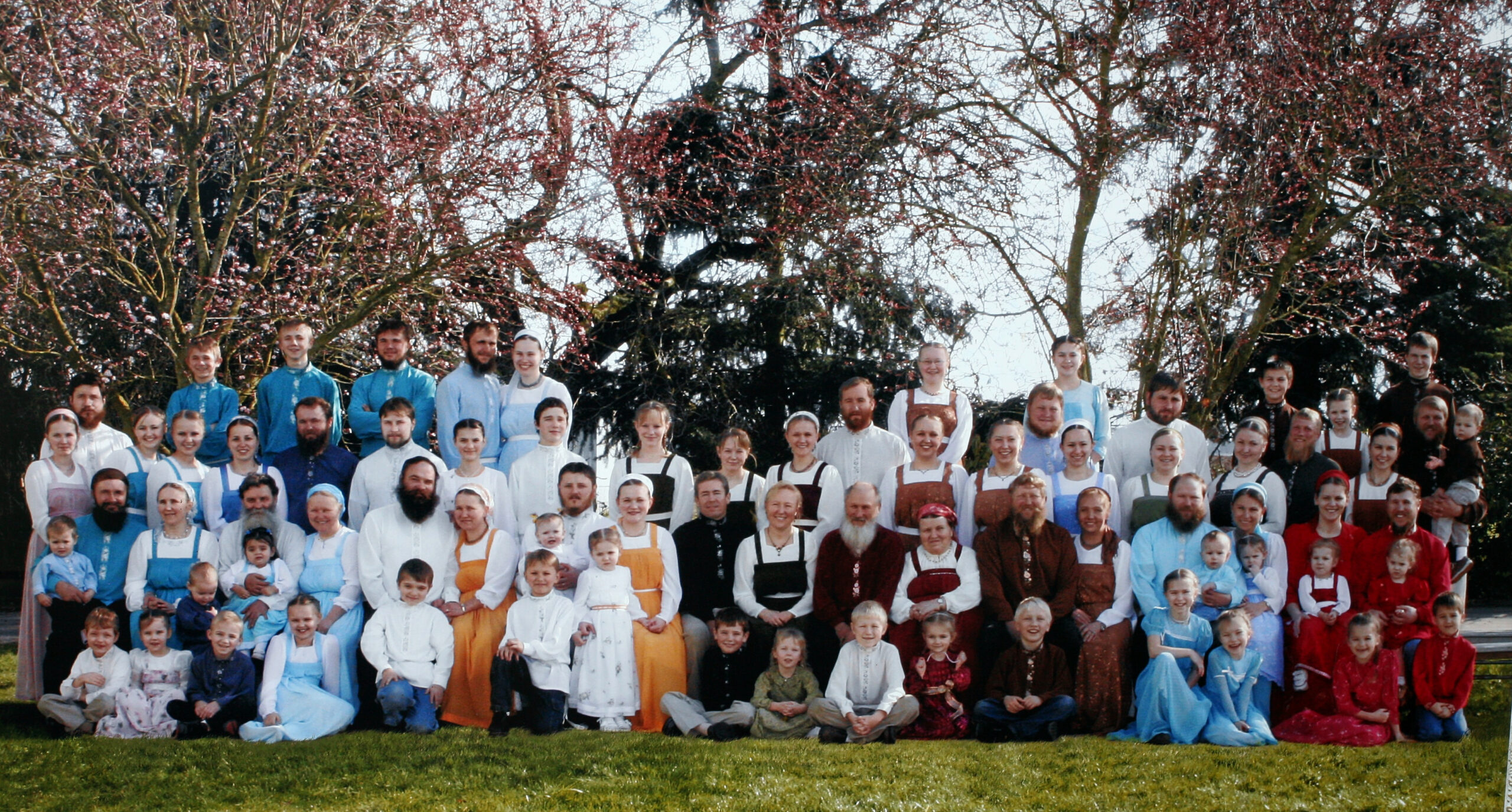
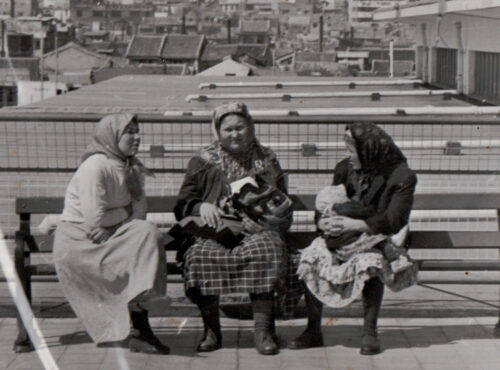
Taisia Zenuhin (right) & Makar’s sister (center) with their babies Hong Kong, 1960 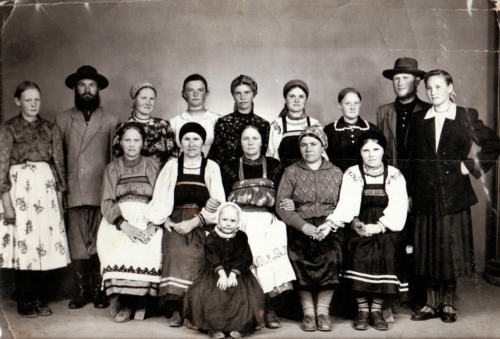
Makar Zenuhin’s family members & friends in Hong Kong 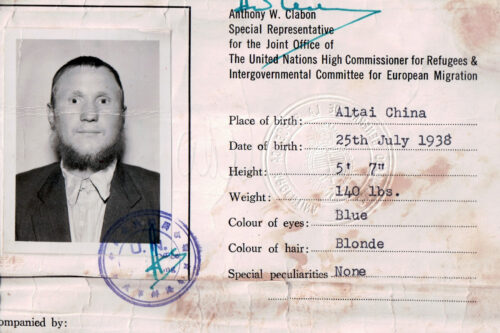
M.A. Zenuhin’s refugee visa, 1960 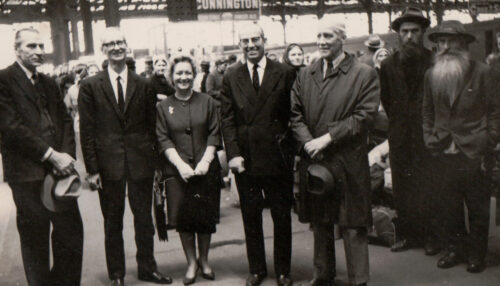
Members of the World Council of Churches meet the second group of Old Believers arriving in Buenos Aires, 1964 or 1965 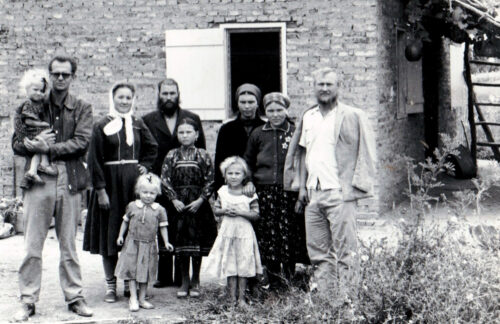
Zenuhin’s family house in Argentina, 1962. Makar & Taisia Zenuhin (right), Sharipov’s family (center), Yuri Trifonov, translator (far left) 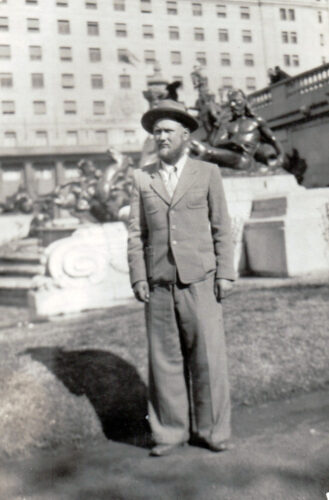
Makar in Buenos Aires; 1963. 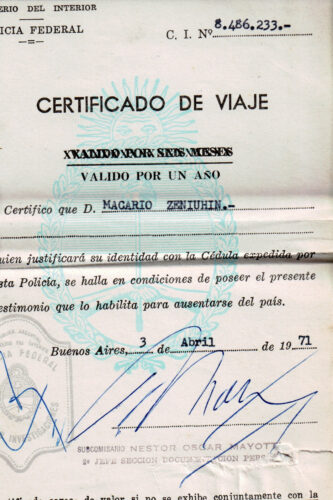
Certificate to travel to the United States given by the Argentinian government 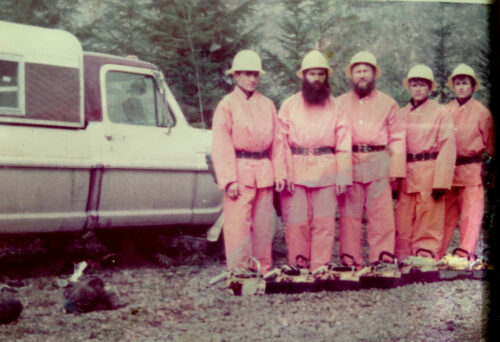
M.A.Zenuhin (center) as part of a forest maintenance crew, in new uniforms. Washington State, 1974 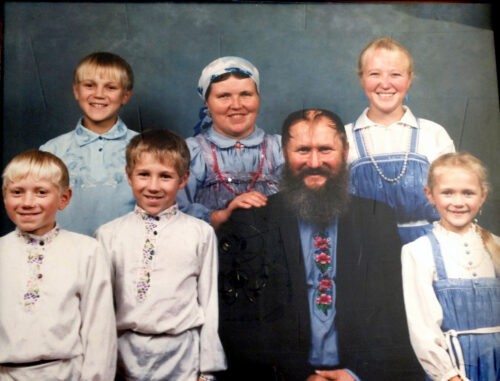
The Zenuhin family with their five younger children Woodburn, Oregon, early 1980s 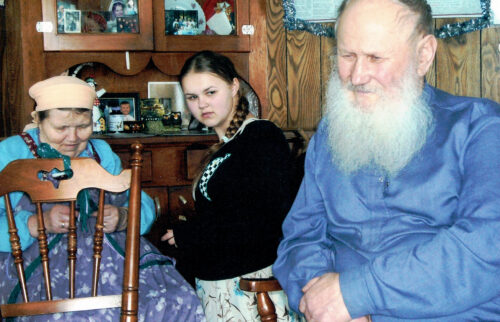
with his wife & granddaughter 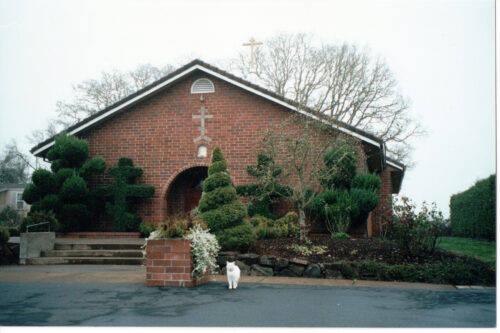
St. Nicholas prayer hall, 2014 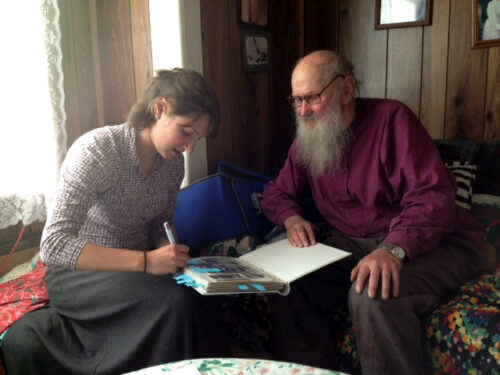
with a Lewis & Clark student Masha Egorenko, 2014
